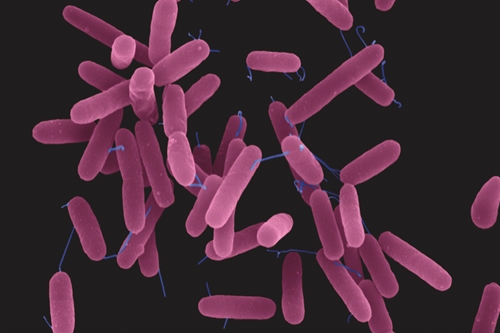
Pseudomonas aeruginosa bacteria (National Institute of Environmental Health Sciences, NIH)
23 May 2017. A materials science and engineering team found a form of graphene produced by lasers can kill films of bacteria resistant to treatment, aided by a weak electric current. Researchers from Rice University in Houston and Ben-Gurion University of the Negev in Israel, describe their discovery in the 18 May issue of the journal Applied Materials and Interfaces (paid subscription required).
The team from the labs of chemistry and materials science professor James Tour at Rice and Ben Gurion’s Christopher Arnusch who studies membranes for water purification sought inexpensive and readily available techniques for killing bacteria in water treatment plants, but can also be used in fighting biofilms that can cause infections in hospitals. Infections in health care facilities are a continuing problem in the U.S., and while the numbers of cases have decreased in recent years, in 2011 some 722,000 people acquired infections in acute-care hospitals, leading to 75,000 deaths.
Tour’s lab earlier discovered a simpler and inexpensive process for producing graphene with lasers. Graphene is a material closely related to graphite like that used in pencils, one atom in thickness and arrayed in an hexagonal atomic pattern. The material is very light, strong, chemically stable, and can conduct both heat and electricity, with applications in electronics, energy, and health care.
Tour and colleagues produce a from of graphene by sending laser beams through polyimide plastic film, a common polymer strong enough to replace glass or steel in many industrial applications. This laser-induced graphene, as it’s called, is made of interconnected nanoscale flakes, rather than the elegant atomic hexagons in pure graphene. But what laser-induced graphene may lack in elegance, it makes up in economics. Polyimide sheets are very inexpensive and this form of graphene can be made in everyday ambient conditions.
Arnusch’s group became interested in laser-induced graphene for its potential to eliminate bacteria in municipal water supplies, where microbial communities form into stubborn films that can foul water pipes. The researchers suspected laser-induced graphene has latent antibacterial properties, but they added a low-power (1.1 to 2.5 volts) to enhance those properties. The team tested electrodes made from polyimide plastic, exposed to infrared lasers to produce laser-induced graphene on their surface.
The researchers assessed the graphene-coated electrodes in a wastewater solution with Pseudomonas aeruginosa bacteria, a cause of serious infections in hospitals, particularly among people with weakened immune systems. The graphene-coated electrodes, with a weak current, first attracted the bacteria, then killed them after coming in contact. In seconds, electrode surfaces with 1.5 to 2.5 volts of current, killed the bacteria, while uncoated polyimide formed biofilms. After 9 hours, the coated electrodes eliminated virtually all (99.9%) of the bacteria and resisted further biofilm formation.
The team attributes these results to the sharp edges on the nanoscale graphene flakes that resist bacteria on their own, as well as hydrogen peroxide produced by the electric current. “This form of graphene is extremely resistant to biofilm formation,” says Tour in a Rice University statement, “which has promise for places like water-treatment plants, oil-drilling operations, hospitals, and ocean applications like underwater pipes that are sensitive to fouling. The antibacterial qualities when electricity is applied is a great additional benefit.”
More from Science & Enterprise:
- Paper-Metal Antimicrobial Layers Designed
- Nanoparticle Vaccine Stops Tumor Growth
- Nanoparticles Boost T-Cells to Fight Leukemia
- Trial Shows Bioactive Glass Stops Bone Infections
- RNA-Nanoparticle Spray Protects Against Plant Viruses
* * *

 RSS - Posts
RSS - Posts
[…] Laser-Produced Graphene Kills Resistant Bacteria […]